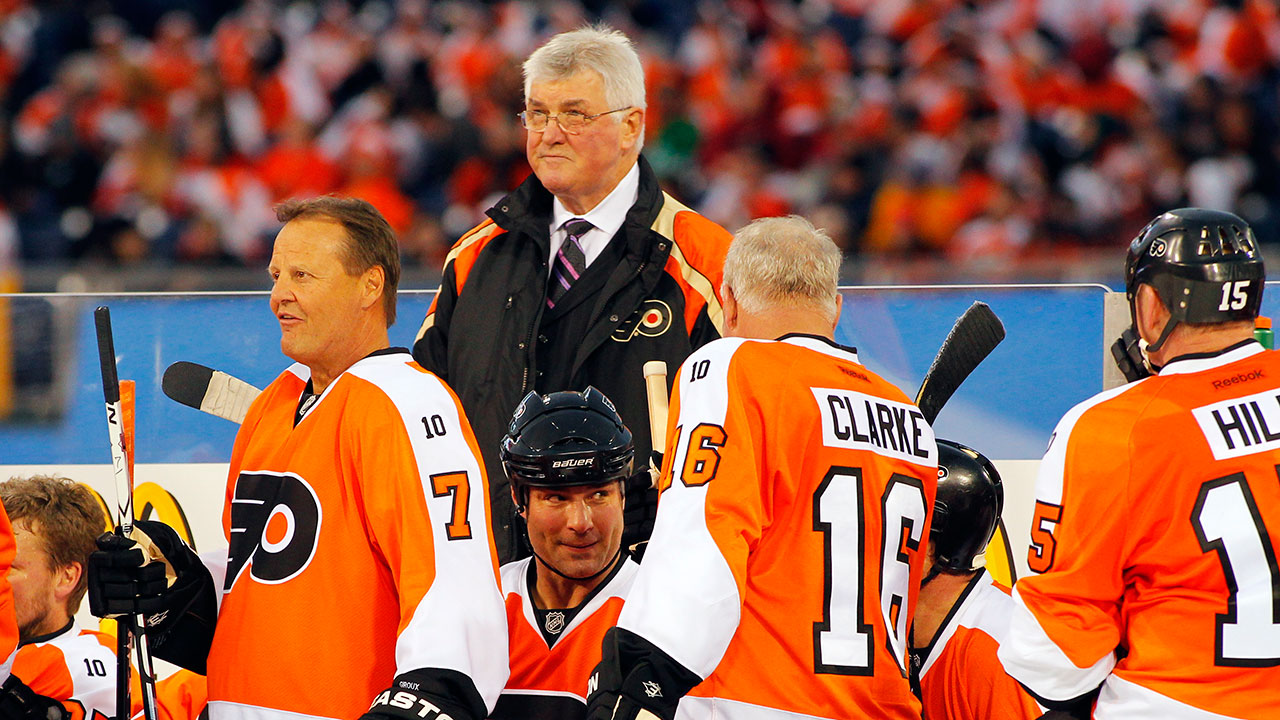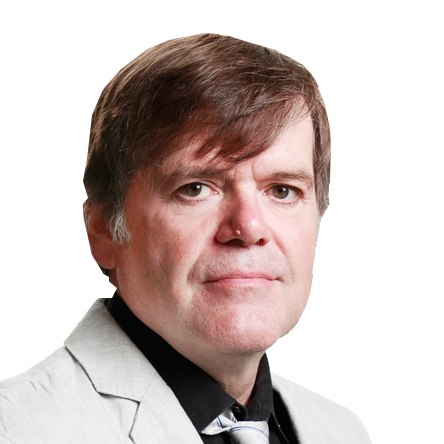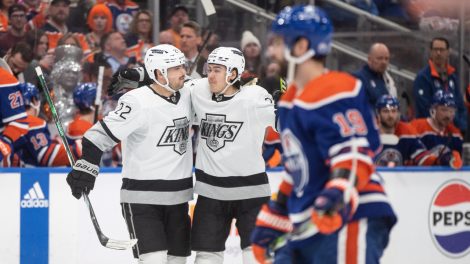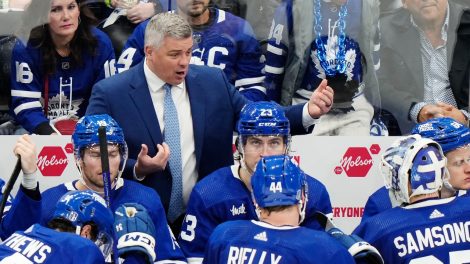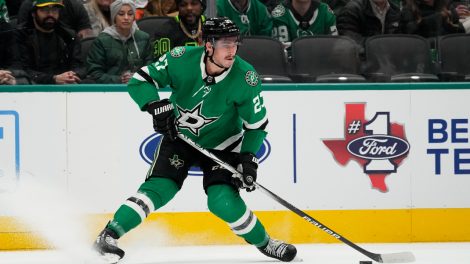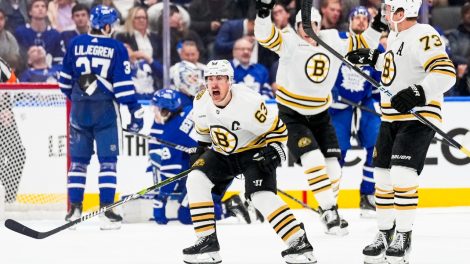If you coach long enough in the NHL you are bound to inherit an average team.
Pat Quinn landed that in his first job as a NHL head coach in Philadelphia midway through the 1978-79 season. The Flyers made it to the second round of the playoffs that spring but weren’t anyone’s idea of a contender. Nor were they one going into Quinn’s first full season with the club. Yet in a shocking turn of events, one unforeseen by experts or in fact the Flyers themselves, Quinn’s team ran up a 48-12-20 record and at one point went unbeaten in 35 consecutive games, shattering the league record.
Tributes to Pat Quinn have poured in since his death on Monday. His long career as a player, coach and executive has been detailed. And inevitably the 1979-80 season gets a mention, probably a line or two, but no more space than is accorded the Flyers’ loss to the New York Islanders in the Cup final that spring.
Quinn’s Jack Adams Award would also be noted, alongside the one he picked up in Vancouver in 1992.
This amounts to a short shrift, at least according to those who played on ’79-’80 Flyers.
“Pat came in and re-invented coaching in the league,” says Bob Clarke, the captain of that Flyers team. “Pat was miles and years ahead of everyone. Teams spent most of the ‘80s catching up. The teams that won went with what he was doing. Teams that lost hung on to the old stuff. Eventually everybody came around. They saw what Pat was able to accomplish with the Flyers.”
To understand what Quinn accomplished in Philadelphia that season, you have to recognize the team that he had to work with. These weren’t Fred Shero’s Flyers. The imprint of the Broad St. Bullies of the mid-70s was fading by then.
The lineup included holdovers from that era: Clarke foremost, Reggie Leach, Bill Barber and Rick MacLeish, but they were in the autumns of their careers.
“The players from those Stanley Cup teams were desperate for change,” Clarke says. “Things had become old and stale for us. He came along when we needed him. Pat had a whole new approach. He changed the basic principles. If you see a hole, fill a hole. Wingers coming in off the wing. All that stuff that everyone uses today, that was what Pat came up to and taught us. No one else was doing it back then. We were an average team. We had average talent in the lineup. Nobody got more out of a team than Pat did that season.”
Quinn didn’t just put the paddles on the chests of veterans like Clarke. He managed to give prominent roles to players with little or no previous NHL experience. None had a bigger role than Brian Propp, a rookie who skated on the first line beside Clarke and Leach.
In training camp, Quinn had veterans take their runs at Propp, a 20-year-old first-rounder straight of Brandon in the WHL.
Propp thought it might be a sign of things to come—Quinn wouldn’t have been the first coach to make an example of a rookie while establishing a tyrannical management style.
It turned out to be the exact opposite.
“He saw that I wasn’t going to put up with anything,” Propp says. “I wasn’t going to see anything worse during the season than I saw in training camp and that gave him the confidence to play me on the first line, right from day one.”
Propp also benefitted from time Quinn put in with him personally. “He taught young players as he went along,” Propp says. “He was a real communicator when it came to details or technical aspects of the game. He related to the players really well—he hadn’t been out of the game that long. He had played against a lot of the veterans and the age difference wasn’t so great between him and any of us in the lineup.”
Quinn might have got the most out of three players who were neither old foes nor incoming stars.
“We played three AHL defenceman a lot that season: Norm Barnes, Mike Busniak, Frank Bathe, the Killer Bs,” says Jimmy Watson, a blueliner who was a hold-over from the Flyers’ Cup champions.
In fact, calling Barnes, Busniak and Bathe AHLers might have been generous. They were journeymen who had played at levels well below the A. Barnes was just a couple of seasons removed from the Baltimore Clippers in the Southern League. Busniak likewise had put in a full season with the Beauce Jaros of the North American League. Bathe was a recent alumnus of the Port Huron Flags of the International League.
Suffice it to say, this troika was not destined to take its place alongside Robinson, Savard and Lapointe. Then again, despite all the talent on the Canadiens teams of any era, not one of their bluelines went 35 consecutive games without a loss like Barnes, Busniak and Bathe did.
“Pat was able to work with the Killer Bs and maybe in a way he could identify with them because he had been a minor-league pro [with Tulsa] before the Leafs called him back in the ‘60s.” Watson says. “What those three showed about Pat is that he had an open mind and was willing to give a player a fair chance of contributing. Who you were and where you had been… none of that mattered. All that mattered is whether you could help or not.”
Looking back on that Flyers team, you wonder exactly how Quinn managed to squeeze so much out of so little. It wasn’t just the Killer Bs. The goaltending on the team was above-average but not much better than that—their streak wasn’t held together by a red-hot netminder.
Phil Myre and Pete Peeters split the job right down the line. Their leading point scorer that season was Ken Linseman, then 21, a very good NHLer, but not in the conversation among all-time greats.
The record book shows that the Flyers went down to the Islanders in six games in 1980 Final. This is one of the times that the record book falls painfully short of telling the whole story.
The record book doesn’t show that this constituted a big upset. Although the Islanders would go on to win three more Stanley Cups and be considered a dynasty, they went into the ’80 Cup final as a prohibitive underdog to Philadelphia—the Flyers had finished with 116 points, 25 ahead of the Islanders that year.
The Islanders had been the close-but-just-short team in the late ‘70s. In fact, rumors had New York general manager Bill Torrey considering a massive overhaul of the roster if they didn’t close the deal that spring.
.
The record book also doesn’t show just how precarious the Islanders victory was.
“We lost in Game 6 in overtime on the Island,” Watson says. “One of the goals was a high-stick, another one was offside. If the right calls are made, we force a Game 7 in Philadelphia and you have to like our chances. It was a hard way to end what was an amazing season. And I really believe if we won that one we would have built on that and won another Cup or two.”
Instead, other teams went to school on Quinn’s work in Philadelphia and worked from his blueprint.
Even though the Stanley Cup eluded Quinn, Bob Clarke is unequivocal about his legacy.
“You go to a practice and see a coach talking to a player one-on-one, personal instruction,” Clarke says. “Pat started that. Without him we wouldn’t have coaches teaching players at the NHL level. That wasn’t done before. Scotty [Bowman] never did that. Fred Shero taught the team but not individual players. They didn’t look at their job as being communicators.
“Pat changed all that. Not to knock anybody, but Pat was the most important coaches of that era,” Clarke says. Even if fans or the media don’t know that, people in the league do.”

